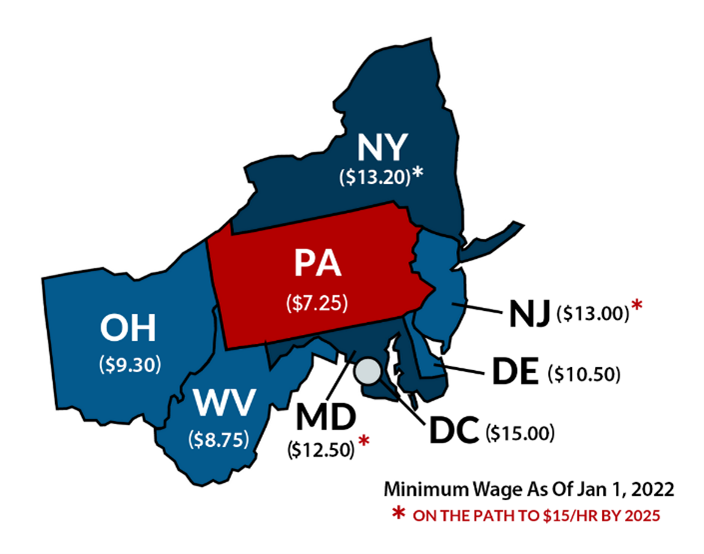Keystone Research Center released its annual report on the economy, “State of Working Pennsylvania 2022,” on August 30. This is the fourth installment of our series breaking the report into bite-size pieces. To access the full report and all the resources associated with the “State of Working Pennsylvania,” please visit our SWPA 2022 Resource page.
This blog focuses on wage trends at the low end of the Pennsylvania job market. While wages have risen in Pennsylvania over the past decade, they have risen more slowly than neighboring states’ wages at the low end, especially wages in New York, New Jersey, and Maryland.
Since 2013, the gap in earnings for low-wage workers in Pennsylvania (at the 20th percentile), compared to New York, New Jersey, and Maryland, has grown from about 20 cents per hour—near parity—to over $1 per hour.
In the low-wage leisure and hospitality industry, the gap in pay between Pennsylvania’s northern-tier counties and neighboring southern-tier counties of New York is truly stunning: a $5,200 yearly difference.
One big reason for these growing gaps: New York, New Jersey, and Maryland legislators have put their minimum wages on a path to $15 per year, while Pennsylvania’s legislative majority has left the Pennsylvania minimum wage at the federal $7.25-per-hour level despite repeated proposals from Governor Wolf to raise it. As a result of legislative inaction, many low-wage workers in Pennsylvania—roughly a quarter of our jobs and about 1.5 million people—earn well below a living wage.
As a result of inflation, today’s U.S. and Pennsylvania minimum wage has 27% less buying power than it did when last raised in 2009 (as figure 18 in the full “State of Working Pennsylvania 2022” report shows). The U.S. and Pennsylvania minimum wages are now at their lowest inflation-adjusted value in 66 years—since February 1956. Minimum-wage workers today earn 40% less than in early 1968, the historic high point in the history of the U.S. and Pennsylvania minimum wages.
Pennsylvania remains unique in the region because all six of our neighboring states have a minimum wage above the federal $7.25 per hour as shown in the image below.
The impact of the differences in state minimum wage policy can be seen clearly in wage trends in our neighboring states compared to Pennsylvania. While wages in the middle and at the top of Pennsylvania’s wage distribution have risen faster than the (weighted) average of wages in our six neighbors, from the 10th to the 40th percentile the opposite is true. (Table 2 in the full report has the details.) Unsurprisingly, the growth in the wage gap, with Pennsylvania at the low end, is more pronounced if you compare us with the three states with minimum wages on a path to $15 per hour: New York, New Jersey, and Maryland. From a mere 20-cent-per-hour wage advantage over Pennsylvania in 2013, the year before New York’s minimum wage first increased, these three neighboring states have seen their 20th percentile wage advantage grow to an average of $1.40 per hour from 2019 to 2021, equivalent to nearly $3,000 per year for a full-time, full-year worker. (See figure 20 in the full “State of Working Pennsylvania” report.)
In our recent update to a study by the Federal Reserve Bank of New York, we found that, despite recent yearly minimum wage increases, leisure and hospitality employment grew more in New York counties that border Pennsylvania since 2013 than it did in Pennsylvania counties that border New York. At the same time, earnings for New York workers have far outpaced those of Pennsylvania workers. In PA-NY border counties, New York leisure and hospitality workers are paid over $100 more per week than their Pennsylvania counterparts: $518 versus $412 per week.
The full “State of Working Pennsylvania” report shows that even a $15 per hour minimum wage would now be below a living wage—a wage high enough to cover a bare-bones family budget without public assistance—in most counties of Pennsylvania.
This recent news story tells you the positions of Pennsylvania’s two gubernatorial candidates on raising the minimum wage.
